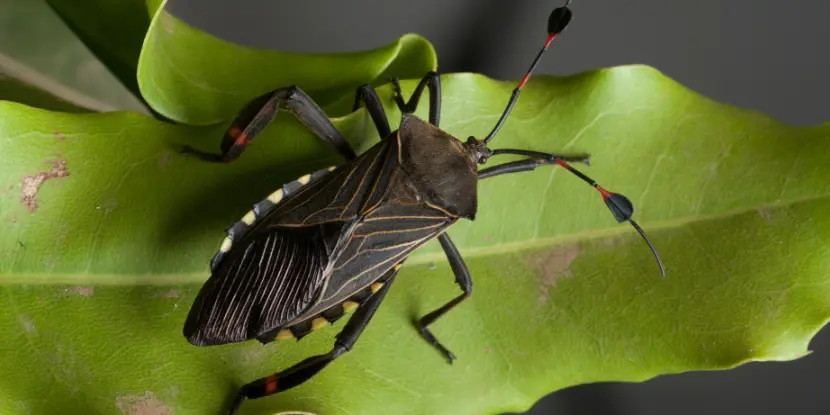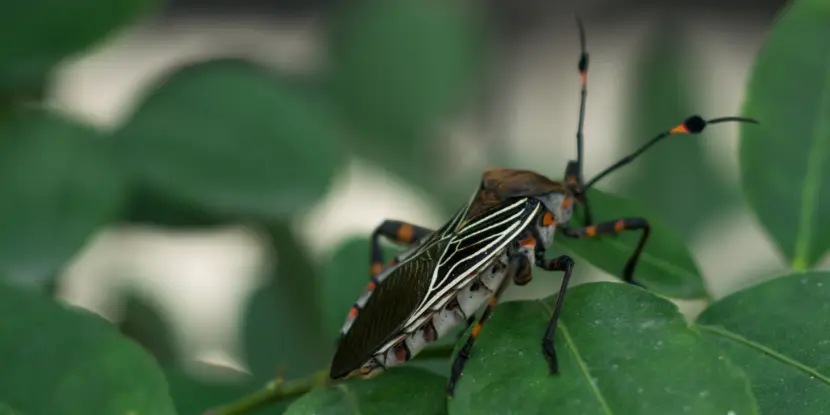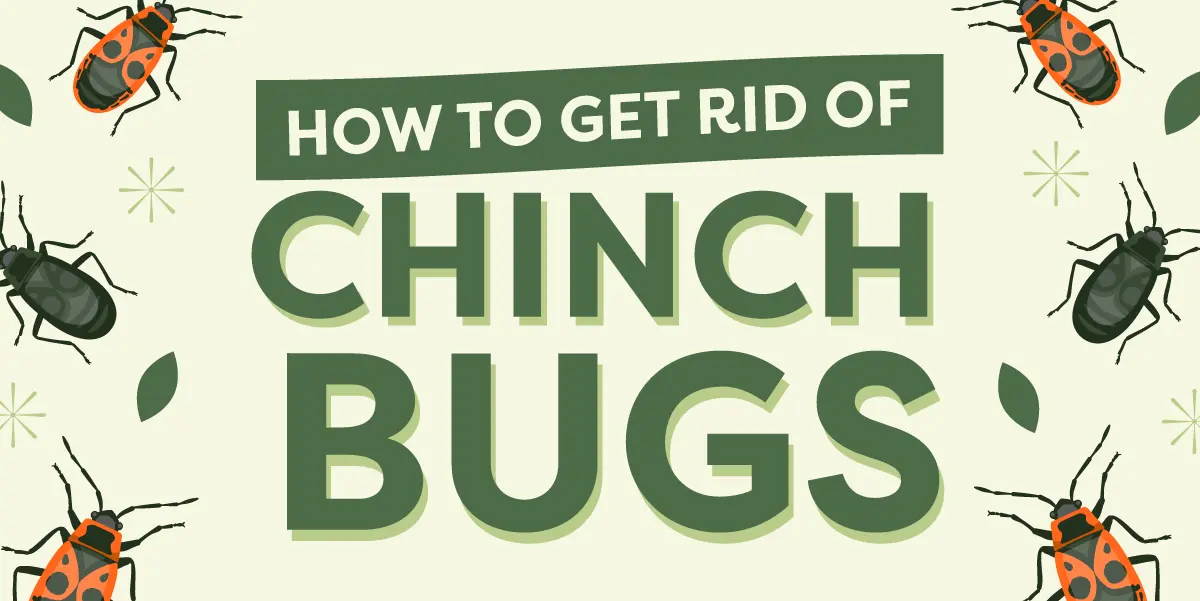Chinch bugs are a nuisance for California landscapes, especially yards with St. Augustine grass. These pernicious pests suck the sap from grass nodes and crowns, causing yellowish to brownish patches.
If left unchecked, they can ruin a lawn in short order. Their small size belies their destructive power. They invade every summer and are at their worst during dry, hot spells.
What’s a Chinch Bug?
“Chinch bug” refers to several species of small insects native to North America. These pests feed on cereal grasses like grains and corn.
They typically have black bodies and white triangular wings that fold over them, but their appearance can vary depending on the species. Adult chinch bugs measure about 1/4 of an inch long, making them hard to spot in the grass.
Immature nymphs are bright red with a white band across their backs, gradually darkening as they mature.
They damage lawns by inserting their needle-like mouthparts into grass blades to extract sap while releasing a toxin that causes the grass to yellow, brown, and eventually die.
The most common species in California is the Blissus Insularis, or southern chinch bug, which prefers warm, dry conditions and reproduces rapidly, leading to populations that can quickly overwhelm a lawn. These soldiers of destruction are usually found in St. Augustine grass but can affect other turfgrasses like centipede grass, Bahia grass, or Bermuda grass.

An adult chinch bug.
Symptoms of a Chinch Bug Infestation
An infestation usually appears as irregular patches of yellowing, wilting grass that eventually turn brown and die. These patches typically start in sunny lawn areas and can spread rapidly.
Another indication is the presence of the bugs themselves. They’re easiest to spot around the edges of damaged areas.
You may also notice an increase in bird activity on your lawn. Birds feed on chinch bugs; your lawn has become an all-you-can-eat buffet!
Eliminating a Chinch Bug Infestation
Dealing with a chinch bug infestation requires a multipronged approach, especially if you prefer non-chemical solutions. Here are some methods to consider:
- Water Your Lawn Properly: Chinch bugs thrive in dry conditions, so maintaining a well-watered lawn can deter their presence. However, avoid overwatering, which can lead to other lawn issues.
- Apply Beneficial Nematodes: These microscopic worms are natural predators of chinch bugs. They can be applied to infested areas.
- Introduce Natural Predators: Birds, ladybugs, and lacewings are chinch bug predators. Inviting these beneficial species to your yard can help keep the chinch bug population in check.
- Use Neem Oil: Applying neem oil as a lawn spray can deter chinch bugs. Neem oil is a natural pesticide that disrupts the life cycle of chinch bugs without harming beneficial insects or the lawn.
- Apply Insecticidal Soap: For immediate areas of infestation, insecticidal soap is a less toxic option than traditional pesticides. It breaks down the outer layer of chinch bugs, causing dehydration.
- Maintain a Healthy Lawn: Regularly mowing, aerating, and fertilizing your lawn according to the needs of your grass type can make it less appealing to chinch bugs.
- Spread Diatomaceous Earth: This natural powder can be sprinkled over the lawn. It pierces a bug’s exoskeleton, leading to dehydration and death.
- Reduce Thatch: Thatch provides a hospitable environment for chinch bugs. Dethatching your lawn removes this protective layer, making your grass less hospitable to pests.

Adult chinch bug with prominent markings.
Chemical Controls
Use a fertilizer to apply a granular insecticide, or spray a liquid on the lawn. Granular insecticides offer preventative control. These include:
- Carbaryl: Also known as Sevin, this provides broad-spectrum control over various pests but can harm beneficial insects like bees and butterflies.
- Bifenthrin Granules: Bifenthrin offers long-lasting protection and can help prevent future infestations when appropriately applied around the perimeter of your lawn.
- Talstar XTRA: Containing bifenthrin and zeta-cypermethrin, this granular insecticide targets multiple lawn pests, including chinch bugs, while providing fast-acting results.
- Merit 0.5 G: Imidacloprid, the active ingredient in Merit, provides systemic control against chinch bugs. It’s absorbed by the roots and moves through the grass, targeting pests but not beneficial insects.
Liquid insecticides have a quicker knockdown effect and are more suitable for active infestations. Some options include:
- Talstar P: With bifenthrin as the active ingredient, this liquid concentrate is effective against chinch bugs and other lawn pests.
- Bayer Advanced Complete Insect Killer for Lawns: This ready-to-spray formula targets a wide range of pests and can be used on multiple grass types.
- Acephate: As a liquid insecticide, acephate works on contact and through ingestion to eradicate chinch bugs.
Preventing Future Chinch Bug Infestations
Once you’ve successfully dealt with a chinch bug infestation, prevention is the best course of action. You can reduce the chances of future infestations by:
- Watch for early signs of chinch bug activity, such as yellowing patches and the presence of adult bugs.
- A healthy lawn is less susceptible to pests. Proper watering, mowing, fertilizing, and aeration contribute to a strong and resilient lawn.
- Avoid relying on a single product if you choose chemical controls. Regularly rotate between different types of pesticides to prevent chinch bugs from developing resistance.
- Overseeding with resistant grass species like Zoysia grass or Bermuda grass can reduce the risk of future infestations.
- Follow integrated pest management (IPM) principles, a holistic approach to pest management that prioritizes non-chemical solutions and uses pesticides as a last resort. These principles can prevent future chinch bug infestations while promoting a healthier lawn and environment.
By adopting a strategic approach, you can manage chinch bug infestations, preserve the lushness of your lawn, and contribute to a vibrant ecosystem. So, stay vigilant and take prompt action at the first sign of an infestation. Good luck and happy gardening!
FAQs: Controlling Chinch Bugs
Q: What are the signs of chinch bug infestation?
Indications include discolored patches in the lawn, weak grass, and a noticeable presence of the insects themselves.
Q: How quickly can chinch bugs damage a lawn?
If left untreated, chinch bugs can kill a lawn in a few weeks.
Q: When are chinch bugs most active?
Chinch bugs thrive in hot and dry conditions, making them most active in summer.
Q: What should I do if I suspect a chinch bug infestation?
Act quickly. Consider using natural remedies or chemical controls, and contact a professional if needed for severe infestations.
Q: Can chinch bugs be controlled without chemicals?
There are several natural and non-toxic options for controlling chinch bugs, such as introducing beneficial predators, applying neem oil, using insecticidal soap, and maintaining a healthy lawn.
Q: How can I prevent future chinch bug infestations?
Regularly inspecting your lawn, practicing good lawn maintenance, rotating pesticides, overseeding with resistant grass species, and following Integrated Pest Management principles can all help prevent future chinch bug infestations.
Q: Can chinch bugs spread to other areas of the lawn?
Yes, chinch bugs can spread quickly, causing damage to larger areas of the lawn.
Q: Are chinch bugs harmful to humans or pets?
Chinch bugs don’t directly threaten humans or pets but can cause significant damage to lawns if left unchecked.
Q: How often should I inspect my lawn for chinch bug activity?
We recommend inspections, especially during the warmer months, to catch chinch bug infestations early.
Q: What are some cultural practices to manage chinch bug populations?
Dethatching and aerating the lawn can disrupt chinch bug habitats and reduce their numbers.

